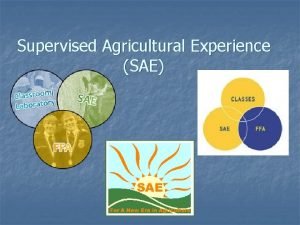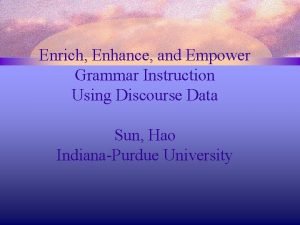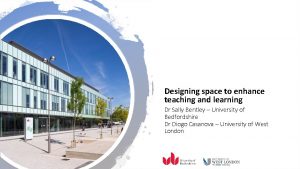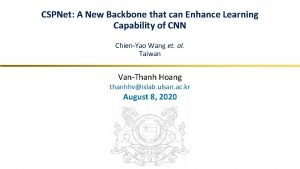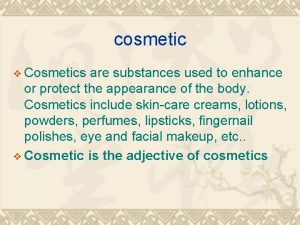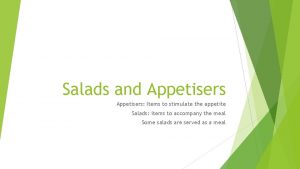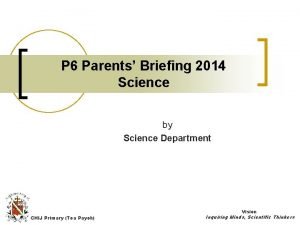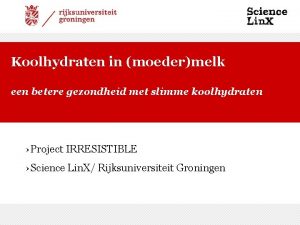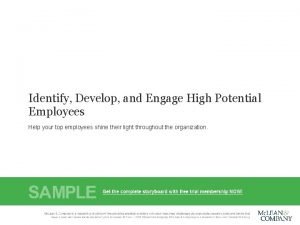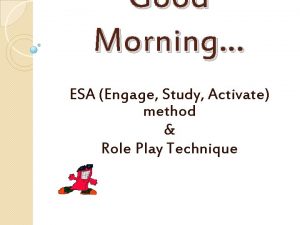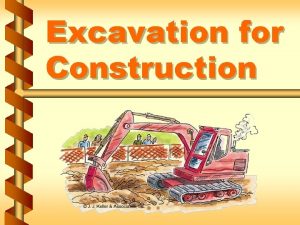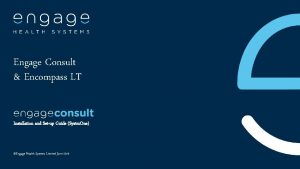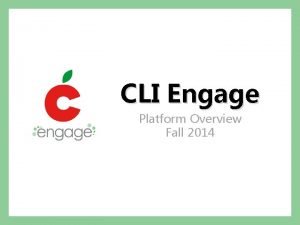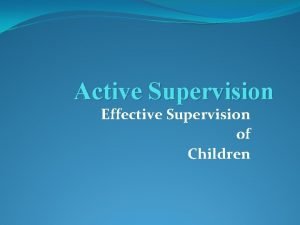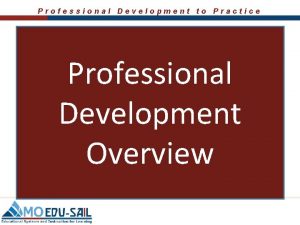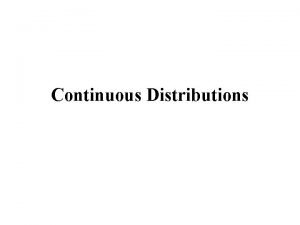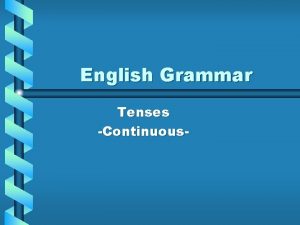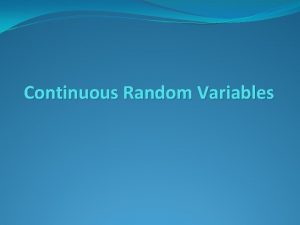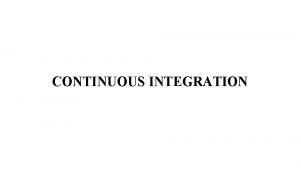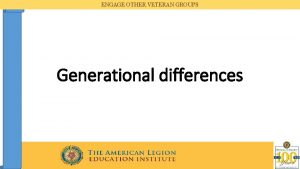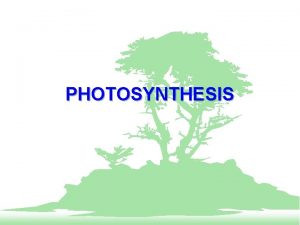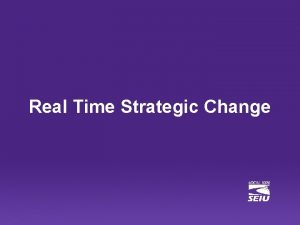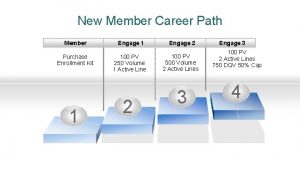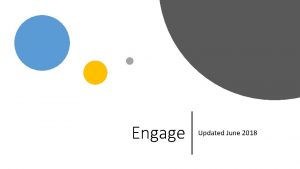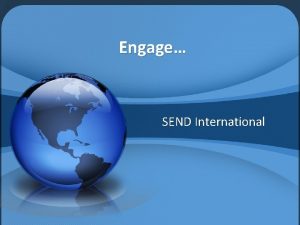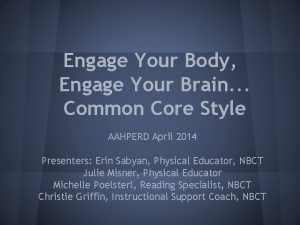Engage in Continuous Professional Development to enhance own






















- Slides: 22

Engage in Continuous Professional Development to enhance own performance

LO 2: Engage in Continuous Professional Development • Teachers and trainers need continuously to evaluate their own practice and identify opportunities for personal and professional development. They need to recognise the importance of, and engage in, evaluation of their own professional practice within the context of internal and external factors that influence their work. They are encouraged to identify targets and plans for their professional development.

Features of the Individuaal professional Development Plan • Be related to specific performance data for the students to whom the teacher is assigned. • Define the inservice objectives and specific measurable improvements expected in student performance as a result of the inservice activity. • Include an evaluation component that determines the effectiveness of the professional development plan.

Every Teacher must have a personal development plan • Require each school principal to establish and maintain an individual professional development plan for each instructional employee assigned to the school as a seamless component to the school improvement plans developed pursuant

IPDP Simplified and Personalized • The individual teacher looks at current students’ specific performance data. • The teacher looks at subgroups within the class • The teacher selects professional development activities that focus on developing personal learning and growth. • The teacher pursues activities to meet individual goals and objectives. • The teacher sets goals and monitors success. • The teacher meets with an administrator to discuss goals. • The teacher participates in professional development. • The teacher has a follow-up meeting with an administrator to summarize progress.

The 3 Parts of the IPDP The Objective Statement Strategies or Resources Evaluation of Results

The Objective Statement • • • Uses data to determine SMART goals. Addresses individual needs to improve practice. Focuses on improving student learning. Connects the educator’s individual goals to student needs. Reflects educator needs as well as the needs of the students, the school, and the district.

SMART OBJECTIVES Specific • Be precise about what you are going to achieve. Measurable • Quantify your objectives. Achievable • Are you attempting too much? Realistic • Do you have the resources to make the objective happen? Timed • State when you will achieve the objective.

Some more on SMART Goals: • Specific – The objective denotes one single key result using an action verb such as plan, write, produce, conduct, etc. Measurable – The objective can be evaluated. Usually we use numbers, percentages, or frequency. Attainable – The objective is realistic in proportion to the available resources. In other words, if a school does not have wireless carts, you cannot state that 75% of the teachers will use Wireless Carts in their classrooms. Relevant – The objective supports the goal of the program, or the needs assessment. Timely – The objective contains a stated timeframe for completion. (i. e. by the end of the session)

Strategies / Resources • Determine strategies or professional development activities necessary to reach goals. • Professional development activities should be job-embedded, continuous and on-going. • Professional development should be focused on student learning.

Examples of Strategies / Resources • • • Participate in a new training and complete follow-up activities Receive coaching or mentoring by a highly effective teacher Conduct action research Learn to use a new technology Conduct internet research Complete a college course Get involved in a a professional organization Keep a journal or a log Join a book-study group

Evaluation of Results • Did student achievement increase as a result of the educator’s professional development? • Were the objectives met? • Does it include a reflection articulating the educators learning?

Undertake Activities: Updating Knowledge Updating Skills Updating Practice Enhancing Subject expertise Awareness of current issues and trends Different approaches and perspectives on teaching and learning • Assessment Practice • • •

Maintain Record: • Formats for keeping record • Updating records • Personal Developmental Plans

Evaluate effect of Professional Development: • • • Feedback from others Identifying changes needed Identifying areas of improvement Learner satisfaction Success rates

Skills for teachers: • Be able to identify for a given topic in a specific subject, the different ways in which ICT could be used to enhance learner achievement. • Be able to apply a mapping/matrix for varieties of learning outcomes to the appropriate ICT tools and resources • To acquire basic ICT skills to use ICT tools and resources and to be able to continuously build and enhance on these skills. • To acquire the skills for training in developing of portfolios (including e-portfolios) to reflect their work and demonstrate evidence of learning acquired.

Additional skills: • To be able to identify suitable resources, from various pools and repositories of sharable learning objects, for their use in classroom context. • To deploy these resources in the learning process to lead to significant ICT usage occurs in a suitable blend of online and offline mode. • To create a teaching-learning event based that includes feedback on formative assessment.

What is Continuous Professional Development? : • Continuing professional development (CPD) consists of reflective activity designed to improve an individual’s attributes, knowledge, understanding and skills. It supports individual needs and improves professional practice. • There are many possible sources of CPD, as shown in the diagram below. Some forms of CPD may encompass elements from more than one of these sources.


More on CPD: • CPD stands for Continuing Professional Development. The term was coined by Richard Gardiner of York University in the 1970’s and did not differentiate between learning from courses and ‘learning on the job’. • The term is now common to many professions. CPD embraces the idea that individuals aim for continuous improvement in their professional skills and knowledge, beyond the basic training initially required to carry out the job. • In teaching, such development used to be called ‘in-service training’, or INSET, with the emphasis on delivery rather than the outcome. Arguably, the change in terminology signifies a shift in emphasis away from the provider and/or employer, towards the individual. In other words, the individual is now responsible for his or her lifelong career development, under the umbrella of the school or schools that employ the teacher.

Characteristics of a Good CPD event: • Economical in terms of time and money • Carefully researched, in terms of teacher needs • Well-presented, preferably by a teacher or a cutting-edge research scientist with relevant teaching experience • Giving plenty of fresh, relevant information • Offering opportunities during the day for reflection upon what was being learnt • Likely to have immediate impact upon their return to the classroom • Likely to improve general subject knowledge and understanding • Offering scope for later follow-up, support and networking • Offering scope for feedback both during the session and later on, beyond the feedback form usually provided on the day

The Top 10 qualities of a good Teacher: 1. 2. 3. 4. 5. 6. 7. 8. 9. 10. Confidence, creativity and a sense of humour Patience and understanding True compassion for their students Very good Presentation Skills The ability to look at life in a different way and to explain a topic in a different way. Dedication to excellence and willing to learn forever and from everyone including the students Unwavering support Willingness to help student achieve. Pride in student’s accomplishments Passion for life
 Analytical sae examples
Analytical sae examples Present progressive with future meaning examples
Present progressive with future meaning examples презент перфект упражнения
презент перфект упражнения Grammar to enrich and enhance writing
Grammar to enrich and enhance writing Fashion cycle
Fashion cycle Enhance an image
Enhance an image Cspnet
Cspnet Cosmetics are substances that are used to enhance
Cosmetics are substances that are used to enhance Enhance an image
Enhance an image Nanyang jc subject combination
Nanyang jc subject combination Enhance life
Enhance life Type of salad which stimulate one's appetite
Type of salad which stimulate one's appetite Can hypnosis force people to act against their will
Can hypnosis force people to act against their will Engage explore explain elaborate evaluate
Engage explore explain elaborate evaluate Engage explore explain elaborate evaluate
Engage explore explain elaborate evaluate Dirpe
Dirpe High potential employee development best practices
High potential employee development best practices Esa engage study activate
Esa engage study activate Engage in excavation
Engage in excavation Vixie engage consult download
Vixie engage consult download Cli engage
Cli engage Active supervision definition
Active supervision definition Ineffective listening
Ineffective listening
